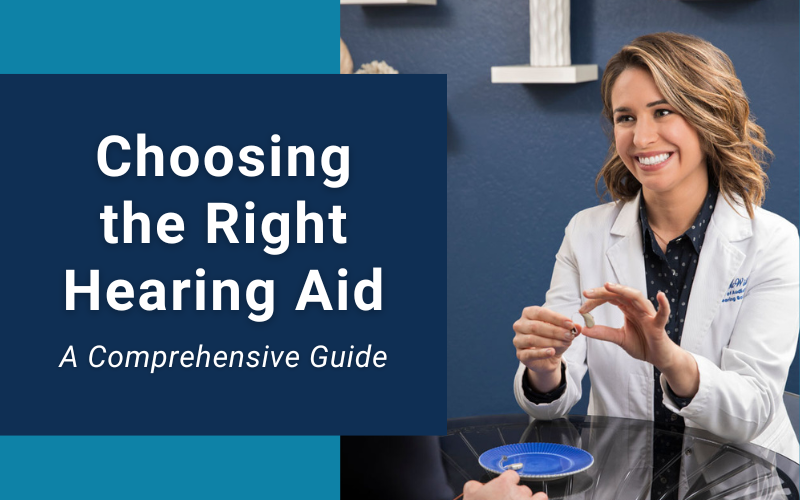Hearing loss can be challenging, but thanks to technological advances, there are now many options to help improve the quality of life for those affected. Choosing the proper hearing aids can feel overwhelming, but understanding your options and needs will empower you to make the best decision. This guide will explore choosing the right hearing aids, considering lifestyle, hearing loss severity, and technological features.
Understanding Hearing Aids
Before selecting the proper hearing aids, it’s essential to have a basic understanding of how they work. Hearing aids are small electronic devices that amplify sound, making it easier for those with hearing loss to communicate and engage with the world around them. They consist of three main parts: a microphone, an amplifier, and a speaker. The microphone picks up sound from the environment, the amplifier increases the strength of that sound, and the speaker delivers it to your ear.
Types of Hearing Aids
There are several types of hearing aids available on the market today, each suited to different kinds of hearing loss and personal preferences. The main types include:
- Behind-the-ear (BTE) Hearing Aids: These are worn behind the ear and are typically more potent than other types, making them a good option for people with severe hearing loss. They can be more noticeable, but they offer durability and ease of handling.
- In-the-Ear (ITE) Hearing Aids: These devices sit directly in the outer ear and are custom-made to fit your ear’s shape. They are generally easier to manage than BTE aids but may not be suitable for severe hearing loss.
- In-the-Canal (ITC) Hearing Aids: These are smaller than ITE devices and fit partially in the ear canal. They are less visible but may be more challenging for people with dexterity issues.
- Completely-in-the-Canal (CIC) Hearing Aids: As the name suggests, these are placed entirely within the ear canal, making them the least visible option. However, their small size limits their amplification, making them best for mild to moderate hearing loss.
Factors to Consider When Choosing Hearing Aids
Choosing the proper hearing aids involves more than just understanding the different types. Several key factors will guide your decision, ensuring your selected devices match your unique needs and preferences.
Your Level of Hearing Loss
The first step in choosing hearing aids is determining the severity of your hearing loss. This is best done through a professional hearing test. Once you understand whether your loss is mild, moderate, or severe, you can narrow down the type of hearing aid that will provide the right level of amplification. People with more severe hearing loss typically need more powerful devices like BTE aids, while those with mild loss might opt for a smaller, more discreet option like CIC devices.
Lifestyle Considerations
Your daily lifestyle plays a significant role in selecting the best hearing aids for your needs. If you lead an active life, participate in sports and social events, or spend much time outdoors, you’ll want a durable device that reduces background noise. Look for features like moisture resistance and directional microphones that can enhance sound quality in noisy environments.
For individuals who often live in quieter environments or interact primarily in one-on-one conversations, simpler devices without as many features may be more appropriate. It’s essential to consider how and where you spend most of your time to ensure your hearing aids fit seamlessly into your life.
Comfort and Fit
Since you’ll wear your hearing aids most of the day, comfort is critical. Hearing aids should fit snugly without causing discomfort. In-the-canal and completely-in-the-canal hearing aids are less noticeable but may cause pain if not fitted properly. Meanwhile, behind-the-ear models are more prominent but more comfortable and easier to handle.
Custom-fit devices are an excellent option for those seeking comfort, as they are moulded specifically to the shape of your ear. Your audiologist can help ensure a proper fit and make adjustments if needed.
Technological Features
Today’s hearing aids have various technological features that enhance the listening experience. Some popular features to consider include:
- Bluetooth Connectivity: This allows you to connect your hearing aids to your phone, television, or other devices, providing a seamless listening experience.
- Noise Reduction: Many modern hearing aids have noise-cancellation capabilities, which can be beneficial in noisy environments like restaurants or public spaces.
- Directional Microphones help you focus on the sounds directly before you, filtering out background noise.
- Rechargeability: Rechargeable hearing aids are an excellent option if you don’t want the hassle of changing batteries regularly.
Be sure to discuss with your audiologist which features most benefit your needs. Depending on your preferences, some features may be unnecessary, while others could significantly improve your overall experience.
The Importance of Professional Support
While it’s tempting to shop for hearing aids online or through catalogues, the process should always involve a qualified audiologist. An audiologist will assess your hearing loss and help you choose the best device. A hearing aids punchbowl of different models, styles, and features may be recommended to match your lifestyle and comfort preferences.
Additionally, professional support is crucial for fine-tuning your hearing aids after you begin using them. You might need adjustments to the settings, and having an expert assist you can make the transition much smoother.
Affordability and Insurance
Hearing aids can be a significant investment, so it’s essential to consider your budget when selecting. Prices can vary widely depending on the type of device and the features included. Some insurance plans may cover part of the cost of hearing aids, so it’s worth exploring your options with your provider.
Conclusion
Choosing the proper hearing aids is a personal journey that requires careful consideration of your hearing loss, lifestyle, and comfort. With the wide range of devices available, from behind-the-ear models to nearly invisible-in-the-canal aids, there’s a solution for everyone. Remember to consult an audiologist to ensure you make the best decision for your hearing health. Feel free to explore the various features available to enhance your everyday experiences. With the proper hearing aids, you can enjoy clear, vibrant sound again and reconnect with the world around you.







